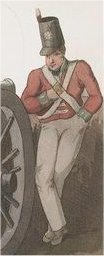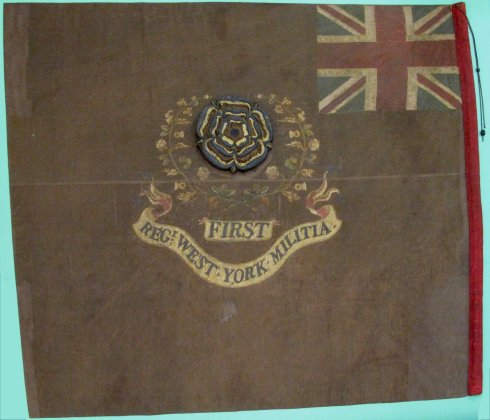Since when has the white rose been the badge of Yorkshire? From the dawn of Time? Since the Plantagenets, at least? Not so, given the useful deconstruction on the site here: the House of York had no physical correlation with Yorkshire, the Yorkshiremen of the 51st Foot wearing white roses at Minden in 1759 seems to be an unattributable myth, dear old Sir Walter Scott coined the term “Wars of the Roses” in 1829, and so on. The white rose was, like tartan, a Victorian invention, then?
In fact, this badge of local identity seems to have more to do with the consolidation of regional military pride encouraged by the development of home defence forces during the French Revolutionary and Napoleonic wars. Royal approval of the use of the white rose by Yorkshire militia regiments was formally granted in 1811, but this merely consolidated existing practice.
The Museum of the King’s Own Yorkshire Light Infantry at Doncaster has a number of colours of the 1st West Yorkshire Militia, which were restored in 1998 with Heritage Lottery Fund help. Among them is this particularly interesting regimental colour. The reverse of the dark green field carries a wreath typical of the post-1800 period, its discreet shamrocks complementing the St Patrick’s cross in the Union. But where the regimental title might be expected to be, at the centre of the wreath, perhaps on a small shield shape, there is now just a greyish conservator’s patch, indicating that whatever was once at the centre has been damaged or cut out. In its place (though now unattached) is a hefty padded white rose, shaded grey and edged in blue.
It seems likely to me that this rose replaced the central regimental title on the original form of the colour, requiring the regimental identity to be added in the form of the two scrolls below; these could well be done by a different hand. If so, this alteration may have taken place in 1804, for in March of that year, after some discussion of a possible new cap plate for the regiment, Adjutant Butterfield informed Colonel Earl Fitzwilliam that “I have returned the Brass Plates, and ordered the White Rose in their stead.” In November 1807, when a new draft of men from the Supplementary Militia joined the regiment, Butterfield noted: “I have ordered 300 Felt Caps and White Roses.”
 In George Walker’s The Costume of Yorkshire, the well known image of a grenadier of the 1st West Yorkshire Militia includes a battalion man in the background who clearly wears a white rose on his cap. Walker’s album of prints was published in 1814, but internal evidence suggests that many of the drawings were done several years earlier. (Officers’ buttons and belt plates of this era also carry the rose, but precise dating of these is difficult.)
In George Walker’s The Costume of Yorkshire, the well known image of a grenadier of the 1st West Yorkshire Militia includes a battalion man in the background who clearly wears a white rose on his cap. Walker’s album of prints was published in 1814, but internal evidence suggests that many of the drawings were done several years earlier. (Officers’ buttons and belt plates of this era also carry the rose, but precise dating of these is difficult.)
So if the white rose of Yorkshire is not as ancient a symbol as we might imagine, neither is it quite as modern as some suppose.
It seems likely that this colour is one of the pair recorded in a regimental history as deposited at Pontefract in 1853 on the reorganisation of the 1st West York, but Doncaster Museum now has no record of how and when it was acquired. Nor can the Museum identify the matching King’s colour, though a Union colour of the same era inscribed simply “G III R” with a crown seems to me to be the most likely candidate. Both colours are now “shut away and … extremely difficult to access”, meaning that the designs of their obverses are currently unknown. No disrespect to Doncaster, and I’m the first to sympathise with the pressures under which museum staff are now obliged to work in the UK, but it’s a worry when museums lose track of the identity and provenance of unique treasures in their keeping. A little basic record keeping goes a long way.



May 26th, 2015 at 1:04 pm
I have just come to this thread from your post on the Napoleonic Wars forum. I look forward to catching up on previous posts. My forbear was in the Fencible cavalry from 1793 to 1799.
With regard to the white rose of York, presumably William Shakespeare had some hand in creating the legend of the ‘Wars of the Roses’ with his scene in ‘Henry VI’ which depicts the supporters of Lancaster and York choosing red and white roses to show their allegiance- whether that was borrowed in turn from Hollinshed’s Chronicle, I can’t recall.
LikeLike
May 26th, 2015 at 3:48 pm
Yes, I think so. And Scott followed Shakespeare.Sorry I’m not too well up on Fencibles. Have to draw the lines in research somewhere!
LikeLike
May 26th, 2015 at 6:09 pm
Indeed. No pressure there. I mention simply as a context. meanwhile I am enjoying the original images you are posting. The original Lofites are a treat.
LikeLike